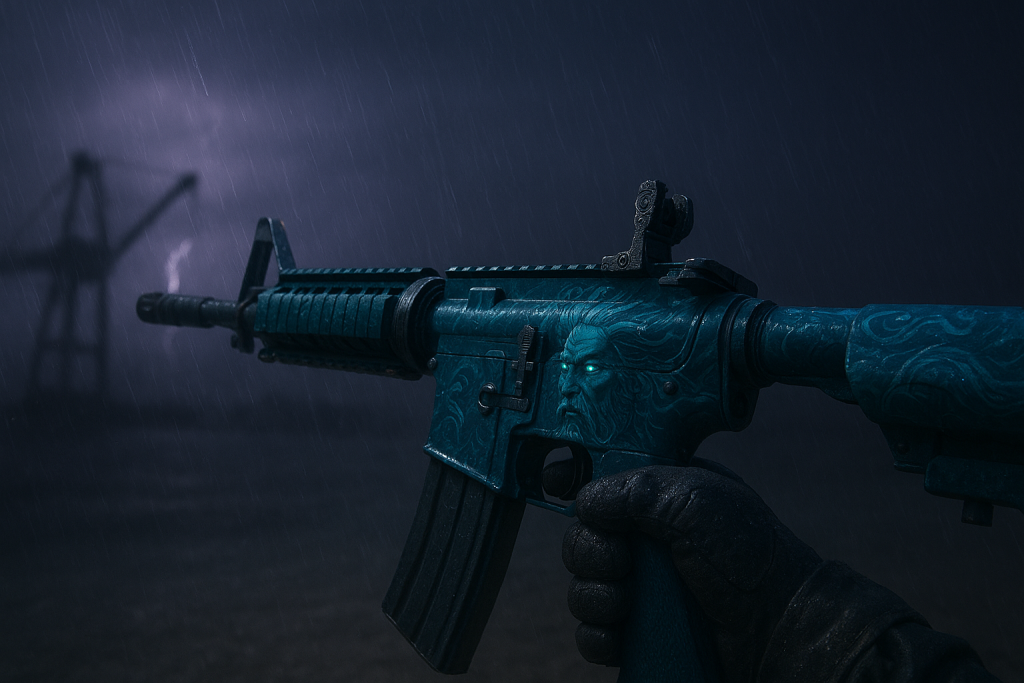Forget the PR fluff for a second and let’s get real about what makes the CS2 world go ’round: the skins. In the sweaty, pixel-perfect thunderdome we call a competitive match, your gun’s finish is more than just a pretty pattern. It’s your flag. It’s a mind game. It’s the silent power move you pull on the whole server before the buy timer even dings. To anyone on the outside, it’s just colors on a virtual toy. But for those of us who’ve dumped an embarrassing number of hours into this life, we know the real deal. The skins that actually mean something, the ones that get the nod of respect, are the ones that have a story. They’re not just JPEGs; they’re relics. That’s the weird magic that turns a bunch of pixels into a legend, where owning a piece of digital history like the M4A4 Poseidon is less about the cash and more about holding a chunk of our collective, chaotic past.
This vibe, this prestige—it doesn’t just happen. It’s a weird stew, cooked up from a killer backstory, a dash of engineered scarcity, and the unspoken agreement of the entire player base that, yup, this is cool. When a skin has a story to it, it stops being just another listing on the CS2 skins market. It becomes a cultural landmark. It’s the difference between a postcard of the Eiffel Tower and actually standing on top of it.
We’re All Suckers for a Good Story
Look, our monkey brains are hardwired to love a good yarn. We’re creatures that hoard stories. It’s why we keep ticket stubs from a great concert, pass down a grandfather’s busted old watch, or get weirdly defensive about a favorite worn-out t-shirt. A story gives a thing a soul. A skin with a slick pattern is neat for a bit, then you get bored. But a skin that hints at ancient gods, digital drama, or a full-blown corporate screw-up? That’s the stuff that gets under your skin. It digs its hooks right into that collector’s nerve we all have.
That narrative layer gives a digital thing a weight its code just can’t measure. It adds a why to the what, making ownership feel earned, not just bought. You’re not just slapping on a new texture; you’re carrying a piece of the game’s universe. This emotional buy-in is the secret fuel for the whole crazy virtual economy. It’s why a tense CSGO skins trade can feel less like swapping stocks and more like two museum curators fighting over a recently unearthed fossil. The story is the invisible ink that makes us believe a handful of pixels is worth a down payment on a car.
The Forbidden Legend: The Story of the M4A4 Howl
If you want one perfect, undeniable example of how lore can literally print prestige, just look at the M4A4 Howl. That skin isn’t an item, man. It’s folklore. When it first showed up back in 2014, its snarling, fiery wolf art made it an instant celebrity. But its climb to god-tier status started with a complete dumpster fire. A copyright notice got slapped on Valve’s desk, revealing the badass wolf art was, well, stolen. A massive, public face-plant.
Valve was stuck. What they did next would shape the skin world forever. Instead of just deleting the skin and memory-holing the whole mess, they pulled a 4D-chess move. They ripped the original case out of the game, had their own artists cook up a new, legally-safe design, and then—the masterstroke—they upgraded every existing Howl to a totally new, never-to-be-made-again “Contraband” quality. With one move, they slammed the supply door shut and accidentally gave the skin the most incredible backstory in gaming. It wasn’t just a cool gun anymore; it was now forbidden art, a digital ghost born from a scandal.
The M4A4 Howl became the ultimate badge of honor for OGs and the mega-rich. Having one says you were either there for a crazy, unrepeatable moment in history, or you had the dedication to hunt one down later. Its price on the CSGO skins market went to the moon, not just because it was rare, but because its story was just that damn good. It’s a tale of theft, a corporate scramble, and a community obsession that turned a legal mess into the undisputed king of all M4A4 skins.
Borrowing a Bit of Immortality
While the Howl’s story was born from CSGO’s own messy reality, other skins get their prestige by tapping into something much, much older: human mythology. The “Gods and Monsters” collection is the prime example. It didn’t just give us some cool art; it injected the modern battlefield with the sagas of Ancient Greece. Items from this collection, like the AWP Medusa or the kingly M4A4 Poseidon, hit different because they come pre-loaded with thousands of years of cultural baggage.
The Poseidon isn’t just a pretty blue CS2 M4A4 skins entry. It’s a whole mural of the Greek god of the sea, trident ready, commanding the waves. When you’re holding it, you’re holding a story of raw, untamable power that’s been told for generations. These mythological skins are a brilliant cheat code for creating prestige because they tap into our collective memory. We all kinda know these stories, and that familiarity makes the skins feel important and timeless right out of the box.
By latching onto these ancient tales, the skins inherit a kind of hand-me-down grandeur. It makes collecting them feel less like a hobby and more like you’re a curator for a digital museum. This is a huge deal for people looking to CSGO skins buy; they’re not just after a new toy, but something with substance. In a market flooded with forgettable designs and cheap CS2 skins, items that connect with our cultural DNA just feel like a smarter bet.
The Player Base is the Ultimate Hype Machine
At the end of the day, a skin’s backstory is just words on a screen until the community decides it matters. Valve can light the spark, but it’s the players who fan it into a wildfire. The wild, chaotic ecosystems of the CSGO skins market and the booming CS2 skins market are living proof. They’re a massive, rowdy jury of peers where the cultural value of an item gets hashed out 24/7.
Flexing a lore-heavy skin in a lobby is a powerful, unspoken move. It’s a social signifier. Loading into a match with a Howl or a Poseidon is a quiet announcement. It says you’re not a tourist. It says you know the history, you get the culture, and you own a piece of it. That social clout is a monster of a motivator. The need to be in that inner circle of collectors is what keeps the whole prestige engine running. It’s what turns a CS2 skins trade from a simple swap of Market CSGO items into a transfer of status.
The most valuable thing in this digital world isn’t rarity or looks—it’s a story. Whether that story is a juicy in-game scandal or a tale borrowed from antiquity, it’s the narrative that separates the legends from the landfill. A skin’s prestige is a tightrope walk between its look, its backstory, and the community that decides to catch it. As CS2 barrels onward, one thing is for sure: the skins we’ll still be talking about in ten years are the ones that gave us more than something to look at—they gave us a story worth telling.

Elara is a dynamic writer and blogger who specializes in pop culture and movie reviews. With a background in film studies and journalism, she combines her deep knowledge of the entertainment industry with a sharp, insightful writing style that keeps readers coming back for more.




![‘Jay Kelly’ Review – Noah Baumbach Makes A Case For The Magic Of Movie Stardom [NYFF 2025] ‘Jay Kelly’ Review – Noah Baumbach Makes A Case For The Magic Of Movie Stardom [NYFF 2025]](https://cdn.geekvibesnation.com/wp-media-folder-geek-vibes-nation/wp-content/uploads/2025/11/Jay-Kelly-JKELLY_20240523_15320_C2_R-300x180.jpg)

